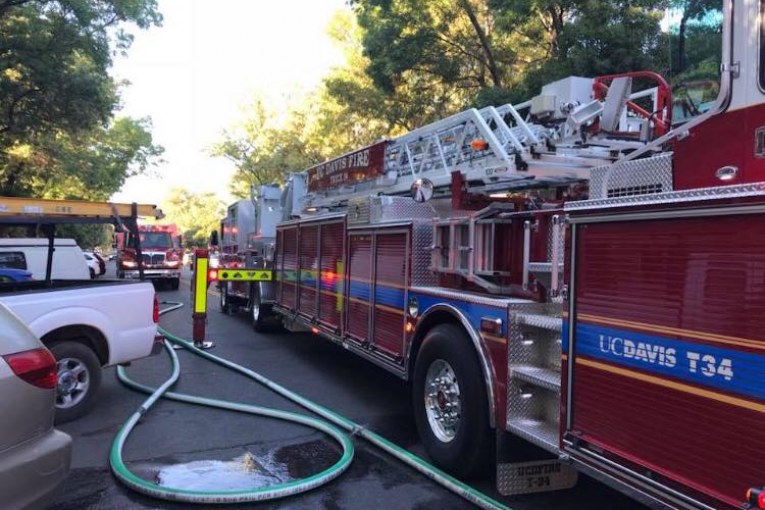

By David M. Greenwald
With the city planning on future densification and taller buildings, one of the key needs was to have ready access to a ladder truck. The council on Tuesday will be asked to direct staff to develop specifications and cost estimates for the manufacture and purchase of a ladder truck.
The anticipated cost here is $1.8 million which would be made using Public Safety Development Impact Fees, which has a current fund balance of approximately $3 million. According to staff, “These funds are specifically set aside from development projects for such acquisitions.”
In addition, staff is recommending that the council house the ladder truck at Station 31.
According to the staff report: “Staff has evaluated the station and some relatively minor modifications to the station could be made to accommodate the truck.”
These modifications, according to staff, “are also anticipated to be funded with Development Impact Fees. Prior to proceeding with ladder truck acquisition staff will return with preliminary cost estimates for the station modifications.”
In addition to equipment and station modification, there may be additional staffing costs associated with the vehicle as well as replacement costs.
“(T)he City maintains a replacement fund for vehicles. The total cost to replace a vehicle is spread across the years of its useful life to determine an annual replacement cost,” staff writes.
That annual cost would be included in the budget each year.
Staff writes: “After replacement, fire apparatus typical spend 10 years in reserve. The ladder truck is recommended to be replaced on a 15-year cycle. Preliminary estimates are $110,000 per year to be set aside for a replacement fund.”
Staff admonishes: “While a ladder truck brings significant fire-fighting, property protection, and rescue strategic benefits to the community (which are difficult to quantify into a monetary benefit), it is imperative that the City Council consider the full cost implications as well, including ladder truck acquisition, facility needs, operations and maintenance, replacement funds, and staffing.”
The ladder truck reaches roughly 100 feet in the air, and staff writes it is “critical to many fire department emergency operations.” They note that “the traditional use of it as a ladder to reach taller structures is only a fraction of the utility that an aerial ladder truck provides. Ladder trucks additionally provide a National Fire Protection Association (NFPA) recommended amount of ground ladders to assist with all fire operations.”
But the city is growing upward with more higher density buildings. The council, for example, recently approved a five-story building at University Mall. The issue of the ladder truck for four-story buildings at DISC came up during the campaign, the downtown plan allows for additional height and density in the downtown, and the staff report notes that the city of Davis already “has over 200 existing buildings that are three stories or higher.”
Currently, “Davis fire engines carry 24-foot ladders that have a limited reach to the roof of a two-story building.”
As noted, “Davis has several projects that are either under construction, such as Lincoln40 and Davis Live, or that have been approved that will be up to 5-7 stories. Furthermore, the Draft Downtown Plan will allow for much greater density in height in the core area of the City.”
Right now, the City of Davis Fire Department relies on mutual aid with UC Davis Fire, and “the City would strategically benefit from having its own ladder truck and has reached a point of development activity of taller buildings that suggests the City consider its own ladder truck to ensure ready, reliable, and trained personnel access to an aerial ladder truck in the event of an emergency.”
The Davis Fire Department “has had multiple fires at our four-story University Retirement Center, which is a high risk building. A ladder truck is a critical resource that responds to all structure fires, regardless of building size or height.”
Staff adds that “this apparatus becomes even more important when the building has multiple stories where firefighters and equipment need access to the roof for ventilation or access to multiple floors for rescue.”
It takes around a year in order to manufacture a ladder truck. During this time, the city plans to modify Station 31.
These modifications, according to the staff report, would include, “Installing a rear roll-up door for apparatus drive through and moving the interior stairwell to outside the south side of the building with the addition of a balcony as a second exit for the second floor. While detailed building cost estimates would require developing plans and obtaining quotes or bids, staff can develop preliminary cost estimates to inform the next steps of the decision making process.”
There would need to be staffing changes, as well, as each of the three ladder companies in Yolo County have four personnel per shift and staff believes that the same approach should be evaluated. However, they note that “alternative staffing approaches, or implementing a gradual shift to this staffing level will be evaluated and brought before the City Council for consideration.”
At present, the vehicle at Station 31 has two firefighters assigned per day and, if this vehicle were approved, the current vehicle would become a back up vehicle.
—David M. Greenwald reporting
Support our work – to become a sustaining at $5 – $10- $25 per month hit the link:


Scary thinking…
I found the above even scarier. Why have there been multiple fires at URC? Why have there been any fires? I don’t think I’d want to have a family member living at a place that has regular fires. What is the story here?